Since last Wednesday, Matteo Baronetto, chef at Del Cambio in Torino for the past 5 years, is directing the kitchen at the Hub of Identità Golose in Milan. He’ll stay until Saturday, the last of 4 dinners. Lucky we, clients, who moved from the intelligent theory of the menu – specifically designed for Via Romagnosi – to its delicious consumption. But it also gave us journalists a rare opportunity as the very busy cook (and entrepreneur) made himself available for half an hour. The result is this interview.
It’s the first time you’re back in Milan to cook, after the 13 years spent with Carlo Cracco (2001-2014). How does it feel?
As I arrived by plane from Paris, I must admit I was a little anxious. It wasn’t performance anxiety, however. Milan is in my heart: this city trained me, it gave me a way to express myself. It was my launching pad. Being back to work for more than one night is strange and it’s thrilling.
The years in Via Victor Hugo were formidable years.
An unrepeatable restaurant, because of the ferment moving it. Those were the years of Ferran Adrià. I applied his lesson with freedom and personality. We listened to the provocations and stimuli arriving from elBulli in a very personal way. It was a message of freedom: copying it would have meant betraying it.
Adrià told us that, once elBulli closed, there had been no more innovation in the kichen.
Ferran is for sure the latest great innovator, the Steve Jobs of dining, a real genius, a word too often abused, but not in his case. However, I only agree to a certain extent: there’s still ferment, what has changed is the conditions in which we innovate. Fifteen years ago, the scene of the avantgarde cuisine was like the artistic one in Milan in the 1960s: Piero Manzoni, Lucio Fontana, Gaber and Jannacci… It seemed like there was no going beyond that, but then some equally great artists arrived.
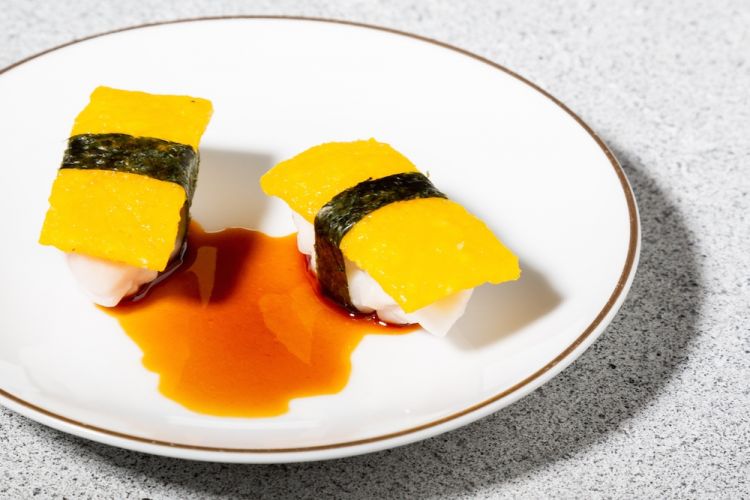
Nighiri, lard, saffron and Italian sauce
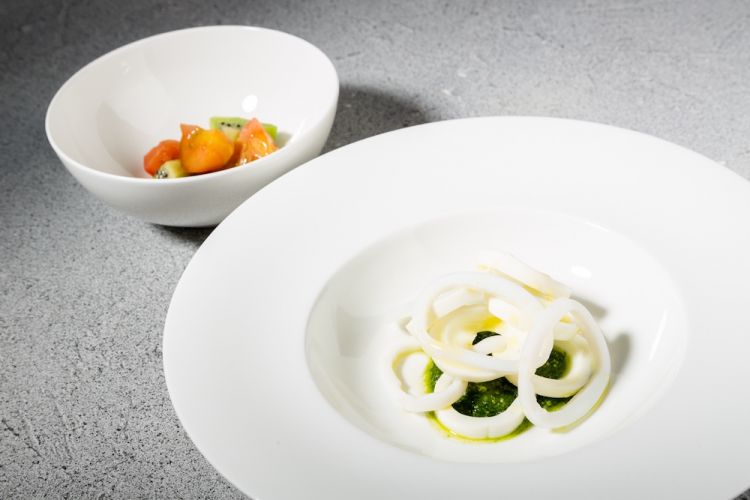
Egg, squid and basil, tomatoes and kiwi
cooked during fertile historical times, times that were receptive to his ideas. In 2007, when I did an internship at
elBulli, one of his sous,
Albert Raurich [now one of the most established cooks in Barcelona], told me that not every dish in the tasting menu had to be necessarily delicious. Even in Via Victor Hugo, not everything that we cooked was delicious. There were some provocations. We could afford it because there was more experimenting and more tolerance at the time. Clients had a stronger propension to try new tastes and dishes. Therefore, cooks had a stronger inclination to dare, to cook dishes that were not mainstream.
Are we more conservative, these days?
We’re more scared. In the past, we’d perhaps dine out four times in a month. Of these, you’d eat good food once, not twice, and by the fourth time you couldn’t understand what had happened, but it didn’t bother you too much. Now you go twice, and you want to eat perfectly each time. There’s a lower margin for freedom. People seek more concreteness. A cook must take into account the fact he has less space for manoeuvring in terms of creativity. But this is not necessarily a bad thing.
What do you mean?
Creativity has shed its skin. At
elBulli it was mostly confined to the dish, and to its model. You now find creativity in the hospitality, in the service, in the interior. It happens even at
Tickets,
Enigma in Barcelona or
Heart in Ibiza, the new establishments of the
Adrià brothers. We give value to elements that were once blurred by the dish. The overall experience has become almost more important than the culinary content. But it’s not this that worries me.
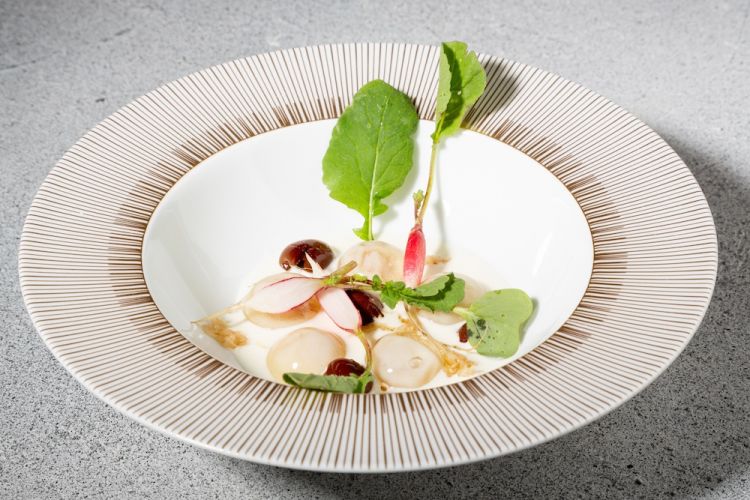
Raviolo with prosciutto in gelatine, olives, black cherries and horseradish
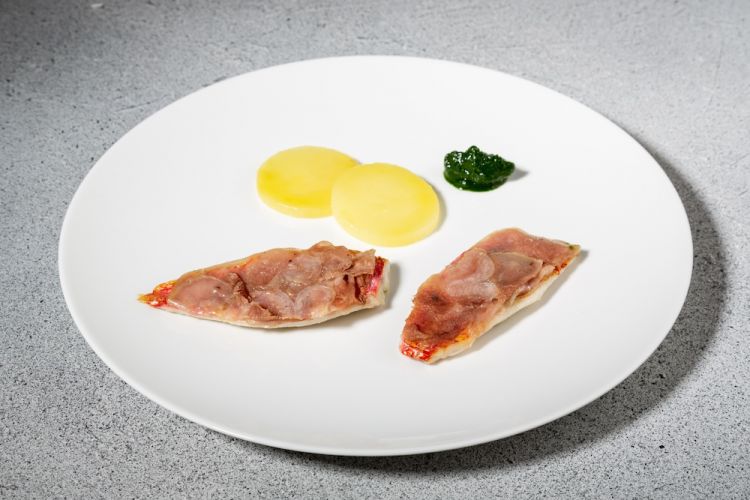
Mullet, veal head, potato with hazelnuts and parsley
This tendency to chase tradition at all costs, something typical of every aftershock, scares me. Making spaghetti with tomato sauce is once again great. There’s nothing wrong, of course, but cuisine has gone far beyond, except people aren’t capable of explaining it. We need someone who can codify this current phase, the work we’re doing.
What do you mean?
It’s hard for me to read a faithful portrayal of what we’re doing. Critics almost always focus on the surface. They very seldom go deeper. There are many cooks who make content in the shade, but would deserve more space and attention. Neglected and often overshadowed professionals while critics should go behind the news, not in front of it, superficially. In cuisine we’re experiencing the same thing that happens in the art world: many exhibitions are now conceived to express the ego of the curator, not the value of the artist. But this is not how it should work.
A crisis of authority?
In 20 years we’ve moved from journalists who tear a restaurant apart, for whom the only news is destruction, to the other excess, where everyone says nice things, summing up everything in an abridged version of banality. Twenty years ago, there was
Edoardo Raspelli’scolumn on
La Stampa or
Paolo Marchi’s on
Il Giornale. Perhaps you didn’t always agree, but they offered a point of reference. A cook wanted to see his name in their columns. Today, if you asked me in which magazine I’d like to end up, I wouldn’t know. And almost always, photos are more important than the story.
And social networks?
Yes, social networks create appeal where there is none. On Instagram everything looks delicious, but this way you only create exaggerated expectations, which are almost never met. The beauty of a dish is in its taste, not in its appearance,
Philippe Regol wrote recently on Identità Golose. It’s very true. After all, was Kidney with sea urchins [an emblem of Via Victor Hugo] a pretty dish?
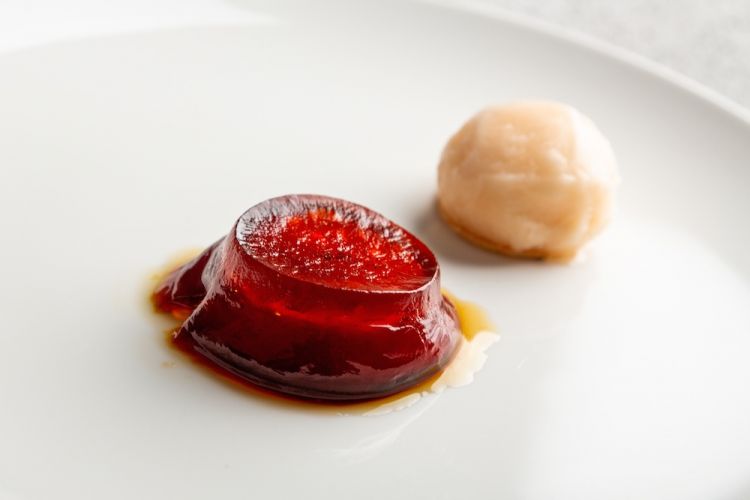
Crème caramel and raspberry sorbet
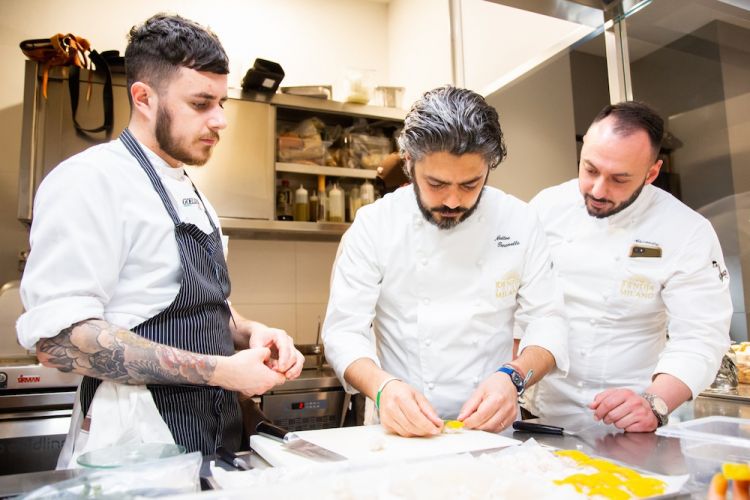
At work with Alessandro Rinaldi, resident chef at Identità Golose Milano (to the right), and Charles Pearce, chef de partie in Via Romagnosi
How can we escape this impasse?
We need a project on food education that starts from simple things. For instance, we could teach kids to recognise primary flavours. But this has to be founded on a deeper story, with no prima-donna behaviours.
Does this task belong to cooks?
No, it doesn’t, because today we’re often asked to be entrepreneurs, managers, psychologists. We don’t even have the necessary tools to build a story on ourselves. We need an impartial point of view on the work of the professionals who have been doing avantgarde for 30 years now. Someone who can trace the road and guide us, explaining what we can convey. Someone who can describe the usefulness that we have today in the world.
Translated into English by Slawka G. Scarso